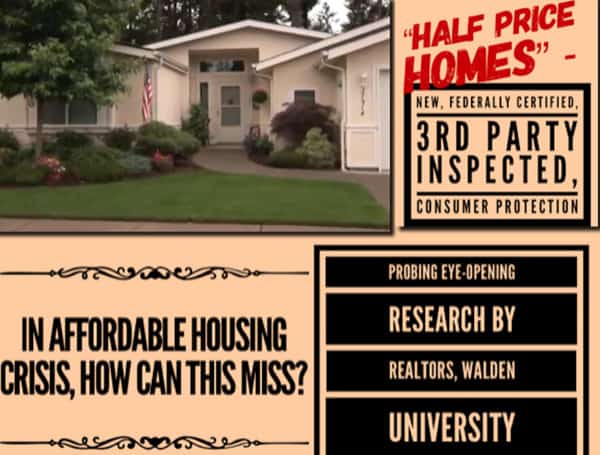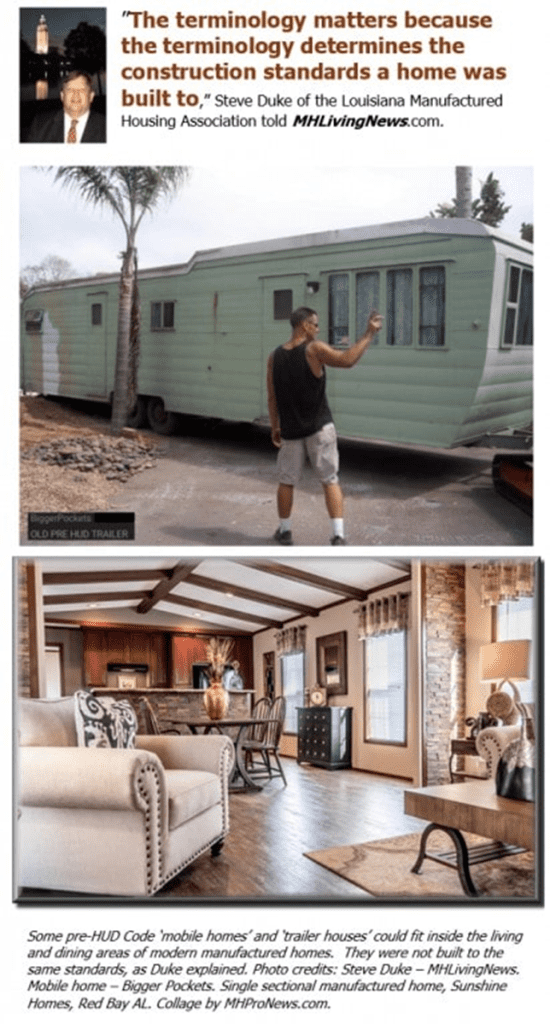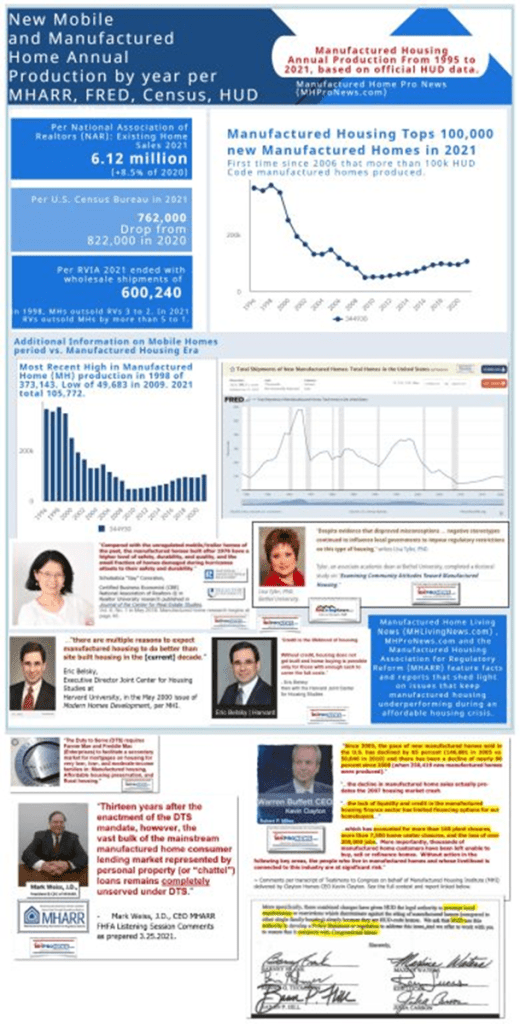Op-Ed By: L. A. “Tony” Kovach
‘If it sounds too good to be true, maybe it’s not true.’ That’s a common reaction to the first part of the headline. An array of semi-automatic notions and human habits kick in. ‘It sounds too good, so it can’t be true, so it must be a scam.’ That’s entirely understandable. There is an evidence-based case to be made that there are several housing scams at play. But those first 17 words are demonstrably 100% accurate. This column includes research from the National Association of Realtors (NAR) and Walden University. It should be obvious that ‘half priced new homes’ could rapidly benefit millions. It could allow renters that jump onboard to start building equity by acquiring engineered homes. This is a surprising, yet proven path for people making less than $50,000 per year to grab their part of the American Dream.
Let’s sift through documented facts, evidence of good news, as well as mention apparent treachery/insights on controversy-creating bad actors.
Ponder the American Dream of home ownership. According to left-leaning Wikipedia and others, over 40 nations worldwide have a homeownership rate higher than the U.S.
Many of those nations have a significantly lower per-capita income than the typical American household.
How can the U.S.A trail the homeownership rate of Romania, Croatia, Hungary, and Mexico – no offense to any of those nations – plus dozens of other countries?
The initial Tampa Free Press op-ed in this periodic series on housing and legal issues harming millions examined competing claims by Democratic lawmakers. Those Democrats are seeking a state of emergency declaration in affordable housing. The counterclaim by popular Florida Governor Ron DeSantis (R) was also considered. Both parties made interesting points.
But according to HUD researchers Pamela Blumenthal and Regina Gray, Democratic and Republican administrations have known the causes and cures to the U.S. affordable housing crisis for 50 years.
In Florida, neither plan advanced would solve the affordable housing problem here or elsewhere. Ouch, but sadly true.
Administrations under both major parties at the state and federal level have discussed various housing plans for decades. A popular definition of insanity is doing the same thing over and over again and expecting different results.
It’s time to stop the insanity and consider something different.
Neither major party has consistently enforced good existing federal laws that could lead to an authentic and proven affordable housing solution.
That housing solution is whimsically described here as “half priced new homes,” why? Because it’s an apt description of new engineered homes – which according to the U.S. Census Bureau – are about half the construction cost of conventional single-family, multifamily, townhouses, condos, etc.
Let’s outline concepts before revealing the secret hiding in plain sight that a Ph.D. from Walden University, a Certified Business Economist (CBE) for the National Association of Realtors (NAR), mainstream media, and dozens of experts that have often praised this unique, proven, and yet controversial housing option.
Facts, Expert Insights, and Controversies About New “Half Priced Homes”
Millions of “half priced new homes” exist in the U.S. today. You may drive by some and not realize it. The still below is from a video interview with a retired realtor and retail management executive living in Westville, IN. But homes like those are found in Florida and states from border-to-border and coast-to-coast.
Thoughtful and pragmatic minds might imagine: if half-priced new homes exist (they do), then the competitors of those homes trying to sell housing at twice the price might hate them. That could explain why competitors often vilify or undermine proven homes in subtle to blatant ways. Some might slur, disparage, demean, diminish, or attempt to ‘regulate’ them in ways favoring competing housing products. Something similar happened in the automotive industry with the famous Tucker Torpedo.
The movie Tucker was based on a true story. It isn’t a perfect analogy, but it arguably sheds light on what has occurred in the U.S. housing industry. It is one reason why the U.S. trails dozens of nations in the rate of homeownership.
While there are rivals who want to toss a useful and proven concept under the proverbial bus, there are also forward thinkers. Rather than battle ‘ half-priced new homes,’ realtors and some builders have embraced them. That’s one of several reasons for sharing the interview with a realtor further below whose husband is a custom conventional housing builder.
In fairness and objectivity, are those half-priced homes perfect? No. But when was the last time you bought a truly perfect…anything?
The ABC News exposé below reminds readers that conventional single-family houses, townhouses, or condos that are double the price aren’t perfect either. “Sometimes the perfect is the enemy of the good” mused the brilliant G.K. Chesterton.
Note that video by ABC isn’t recent. But numerous video reports like it have been produced by various news services before and since.
Nothing made by human – or robotic – hands is fault-free. While not perfect, new so-called ‘half-priced homes’ are durable, proven to appreciate in value, and studies by a range of third parties have proven them as safe as conventional housing.
This modern marvel of engineering is often affordable to millions whose incomes might otherwise keep them from ever owning more costly permanent housing alternatives.
All this boils down to an affordable and practical housing solution that demands attention. Who says? The Washington Post,1 USA Today,2 and two studies by the Urban Institute3 (perhaps the latter is the best of those mentioned reports) among others.
What is this modern housing engineering marvel? Why is it one of the ‘best-kept secrets’ in America during an affordable housing crisis?
In case you are wondering: is it a ‘mobile home?’ Or the dreaded ‘trailer house?’ The answer to both of those questions is candidly ‘no.’ But there is a connection…
…because it is a HUD Code manufactured home, one of the most misunderstood, yet also celebrated and highly researched types of permanent homes available today.
To illustrate the difference between a trailer house, a mobile home, or a manufactured home, the illustration below tells the tale at-a-glance. Trailers aren’t mobile homes. Mobile homes aren’t manufactured homes.
The longer-form video interview below (with outtakes) is with Berkshire Hathaway HomeServices real estate broker Linda Hazelhoff. Hazelhoff explains her husband is a custom builder. She’s sold hundreds of manufactured homes, which she says her clients enjoy.
The discussion reveals insights tens of millions of affordable housing seekers have never considered.
Neither she nor her firm commissioned this interview. Nor was she compensated for her comments. Hazelhoff volunteered to tell her professional experience. As she says during the video interview, she has spoken in a seminar format to other realtors about modern manufactured homes. So have public officials, homeowners, housing professionals, inspectors, and others we’ve spoken with over the years in numerous states, including Florida.
Linda.Hazelhoff, Real Estate Associate Broker, Kalamazoo, MI from .
That video is a few years pre-COVID-19. So, prices on all housing have risen. That said, the percentage of savings (about half) is similar today as then.
In this writer’s experience, manufactured homeowners are routinely willing – sometimes even excited – to share their experiences about manufactured housing and manufactured home living. They are often tired of the stigma. Factory-built homeowner and advocate Rev. Donald Tye, Jr. said that manufactured homes are unjustly overlooked for similar reasons – bigotry and prejudice – that harmed blacks and other minorities for years.
But to be objective, there are those who have had experiences with manufactured homes, often in land-lease communities, that are not as positive. Those valid concerns about so-called “bad actors” and “predators” will be explored in a planned follow-up to this evidence-based op-ed.
In the photo collage below, every home shown is a modern manufactured home. Yes, that two-level (two story) home is a HUD Code manufactured home too.
As a result of scandals involving some (not all) mobile homes built in the trailer house and mobile home eras that had thin walls, poor insulation or that used materials that were fire hazards, ‘better’ mobile home builders sought and obtained federal regulation.
Congressionally enacted federal manufactured housing regulations passed into law in 1974. They mandated construction, safety, and energy standards for mobile homes that thereby gave birth to HUD-regulated manufactured housing.
Consumer safeguards, such as third-party inspections in every manufactured home production center, were also mandated.
That federal-industry response aimed at correcting problems during the 1960s and early 1970s about ‘cheap’ mobile homes. The implementation of those standards for manufactured homes became federal law occurred on 6.15.1976. Those standards are commonly called the HUD Code for manufactured housing.
The HUD Code is the first, and still only, national building code for single-family housing.
Matchneer was the first administrator for the HUD Office of Manufactured Housing Programs (OMHP). Matchneer revealed insider insights other public officials, as well as the affordable housing-seeking public, should learn.
- Part of how costs are saved in building manufactured homes is due to a simplification of the building process.
- By “preempting” state or local standards for construction, the HUD Code allows factory-builders in Alabama, for example, to build a home destined for Illinois, Kentucky, or Florida. Those homes will meet the energy and construction standards for the destination where it will be permanently installed for residential living.
This video interview shows clips and stills that illustrate trailer houses, mobile homes, modern manufactured homes, and addresses the common concern about tornadoes. Among the linked resources at the end of this Free Press op-ed are reports on common concerns 3rd-party research has clarified or debunked.
- Another way costs are saved and passed onto homebuyers of manufactured homes is because building materials are purchased in bulk quantities.
- The homes are built indoors. Weather has little impact on the home-building process. Theft of building materials is cut too.
- Labor costs and time are saved by factory building too.
- Recycling is more efficient in plant, which makes the homes ‘greener.’
Before 6.15.1976, homes delivered to the site on a permanent frame were commonly called “mobile homes.” Since June 15, 1976, the homes are legally referred to as “manufactured homes.”
The Associated Press (AP) Stylebook has told MHLivingNews that they plan to do an update to mainstream media to clarify the differences between mobile homes and manufactured homes. So, this isn’t a marketing difference. The terminology refers to construction standards with legal distinctions.
Let’s sum up, tee up the next op-ed in this series, and close this column.
- We opened with the idea of ‘half-priced new homes.’ Compared to conventional construction on site, that’s 100 percent accurate, per the U.S. Census Bureau and other 3rd-party research.
- This acknowledges there are bad actors in our profession, just as there are in others. In an upcoming op-ed, we’ll explore certain bad actors by name and with evidence.
- Additionally, we plan to include tips and strategies to limit the harm done and punish bad actors, again, by using existing laws.
- Perhaps near the top of the list of important facts is that the Manufactured Housing Improvement Act of 2000 (MHIA). It is one of several pieces of existing legislation that provides consumer safeguards.
- The MHIA also has “enhanced preemption” that HUD has sadly used only sparingly. This series will explore that issue too, noting some light has been shed on that in the first article to the Tampa Free Press linked here.
- Note that preemption wouldn’t impact deed-restricted properties.
- While some try to undermine the reputation and acceptance of modern manufactured homes, the interview with Linda Hazelhoff illustrates a different approach. Realtors and builders could embrace manufactured homes instead of disparaging them.
- Modular Home Building Association (MHBA) Executive Director Tom Hardiman said in a statement we’ll explore later that he will never disparage a manufactured home. Hardiman said that because manufactured homes have well-served and are needed by millions. His association is a competitor to manufactured housing. But Hardiman told MHLivingNews that an “all of the above” plan – meaning all types of housing – are needed to meet the demands for the current housing crisis.
In a highly polarized society, is not possible to tell the truth without offending someone. But, as the late Senator Daniel Patrick Moynihan (NY-D) famously said, “You are entitled to your own opinions, but you are not entitled to your own facts.”
The headline began with: “Half Price Homes” – New, Federally Certified, 3rd Party Inspected, Consumer Protection.” The second part of the headline said, “in Affordable Housing Crisis, How Can This Miss?” The evidence reflects that manufactured home sales are up from a dozen years ago. But they are nevertheless operating at only about 29 percent of its prior high in 1998. That troubling reality merits legal oversight and investigation.
As promised, quotes from Walden University’s Lisa Tyler4, Ph.D., and Scholastica “Gay” Cororaton5 with the NAR are among those shown below. Their research documents are linked in the footnotes.
The graphic below is one of numbers from Cororaton’s report. It indicates that many, perhaps most renters, could afford a manufactured home for the same or lower monthly payment than renters pay.
Given this largely good news, why is there such underperformance by manufactured housing? That will be a focus on an upcoming follow-up to this periodic evidence-based analysis and expert commentary series exclusively on The Free Press-Tampa.
Millions need this solution. Until next time, the links below found on the Free Press shed additional light from related research and reports.
Image credits for unlabeled images:
- Featured image at top of a residential style manufactured home with an integrated garage is provided courtesy of Florida-based Triad Financial Services. It is used with permission.
- The image from New Durham Estates is of ‘ground set’ manufactured homes with garages are stills from a video interview by Inside MH by Manufactured Home Living News (MHLivingNews.com).
- The photo collage below gives visual examples of the difference between ‘entry-level’ or ‘shade and shelter’ manufactured homes (the most economical ones, which still meet all HUD construction, safety, and energy standards). Others shown are ‘residential style’ manufactured homes, also built to meet or exceed all federal standards. That collage is courtesy of MHLivingNews. Yes, the two-story home is a HUD Code manufactured home in Justice, IL.

Footnotes and related references:
- Washington Post: https://www.washingtonpost.com/realestate/a-factory-built-home-as-a-means-to-affordable-housing/2021/09/08/289c504a-e0fa-11eb-9f54-7eee10b5fcd2_story.html
- USA Today: https://www.usatoday.com/story/money/personalfinance/real-estate/2022/01/19/housing-market-mobile-manufactured-homes/6560248001/
- Each of these reports merits some level of fisking, perhaps the best of these 3rd party references are the two Urban Institute reports linked below:
- https://www.urban.org/urban-wire/manufactured-homes-could-ease-affordable-housing-crisis-so-why-are-so-few-being-made
- https://www.urban.org/urban-wire/new-evidence-shows-manufactured-homes-appreciate-well-site-built-homes
4. Per Walden University regarding Lisa Tyler’s dissertation, “This is to certify that the doctoral study by Lisa Tyler has been found to be complete and satisfactory in all respects, and that any and all revisions required by the review committee have been made.” That was acknowledged by Review Committee Dr. Jose Lopez, Committee Chairperson, Doctor of Business Administration Faculty Dr. Judith Blando, Committee Member, Doctor of Business Administration Faculty Dr. Chirstos Makrigeorgis, University Reviewer, Doctor of Business Administration Faculty Chief Academic Officer Eric Riedel, Ph.D. For those – like myself – who do not have a doctoral degree and may have limited experience with the top levels of academic investigations, there are several standards that must be met including peer review. Note as a disclosure that both Cororaton and Tyler graciously mentioned this writer and our trade media (MHProNews.com and MHLivingNews.com) in their acknowledgements and/or via a footnote. But so too has the Consumer Financial Protection Bureau (CFPB), mainstream media, and others who think of this writer as an “expert” (cue up ‘drip under pressure’) in manufactured housing.
5. Scholastica “Gay” Cororaton’s NAR research on modern manufactured home starts on page 48.
Additional References found on the Tampa Free Press at the Links Shown.
- Affordable Housing, Mobile Homes, Manufactured Homes, Manufactured Housing Research–Gov, Univ, Nonprofit Data & Studies January 1, 2022
- LendingTree “Mobile Home Values Are Rising Faster Than Single-Family” Homes-Why Manufactured Homes Appreciate/Depreciate January 10, 2022
- Causes-Possible Cures Affordable Housing Crisis-Monopolistic Moat-Sabotaging Monopolies-Manufactured Home Controversies January 12, 2022
- Preliminary Tornado Data 2021 National Weather Service, III.org–Surprising, Hopeful Facts for Affordable Housing Seekers January 16, 2022
- Why is Manufactured Housing Underperforming During an Affordable Housing Crisis? Legal Updates, Reports Explore Concerns January 31, 2022
- Op-Ed: “State of Emergency” – Democrats, Gov. DeSantis And Competing Affordable Housing Crisis Plans And Solutions Examined February 13, 2022
- Swift Relief Possible Because No New Legislation Or Spending Required Op-Ed By: L. A. “Tony” Kovach Regional…“State of Emergency” – TampaFP Issues MHProNews Report on Democrats v Florida Gov DeSantis on Affordable Housing CrisisFebruary 15, 2022
Visit Tampafp.com for Politics, Tampa Area Local News, Sports, and National Headlines. Support journalism by clicking here to our GoFundMe or sign up for our free newsletter by clicking here.
Android Users, Click Here To Download The Free Press App And Never Miss A Story. Follow Us On Facebook Here Or Twitter Here.









